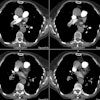Acute pulmonary embolism: diagnosis with MR angiography.
Gupta A, Frazer CK, Ferguson JM, Kumar AB, Davis SJ, Fallon MJ, Morris IT, Drury PJ, Cala LA
PURPOSE: To prospectively evaluate pulmonary magnetic (MR) angiography
as a diagnostic examination for acute pulmonary embolism (PE). MATERIALS
AND METHODS: Thirty-six consecutive patients (19 women, 17 men; age range,
28-84 years) underwent pulmonary digital subtraction angiography (DSA)
and pulmonary MR angiography. MR angiograms were obtained during suspended
respiration and the pulmonary arterial phase of gadolinium-based contrast
medium injection. A steady-state gradient-recalled-echo sequence with free
induction decay sampling was used. DSA studies were interpreted for the
presence of acute PE by two independent radiologists; an adjudicator made
the final decision on discordant interpretations. RESULTS: By using DSA,
a total of 19 acute pulmonary emboli were depicted in 13 patients. Prospectively,
13 of these emboli were depicted by using MR angiography. MR angiography
missed six emboli: Four required the DSA adjudicator to make the decision,
and one was in a patient whose MR angiogram was acquired during breathing.
Four of these six emboli were small subsegmental emboli, and two were segmental.
CONCLUSION: Performed without pulmonary arterial catheterization, iodinated
contrast media, or ionizing radiation, pulmonary MR angiography had a high
accuracy for depicting lobar and segmental emboli, but was unable to depict
four of five subsegmental emboli.
Comments:
Comment in: Radiology 1999 Feb;210(2):301-3
PMID: 10207414, UI: 99223821







